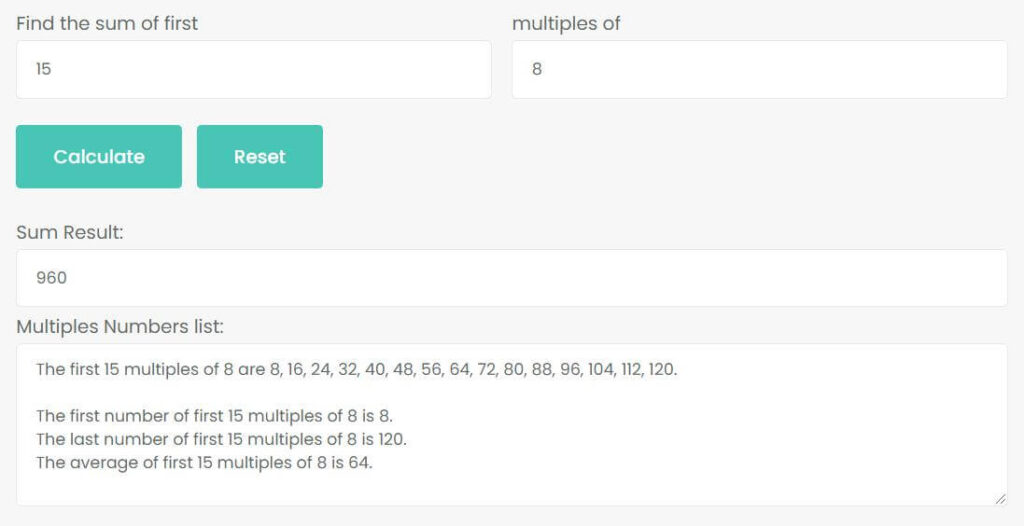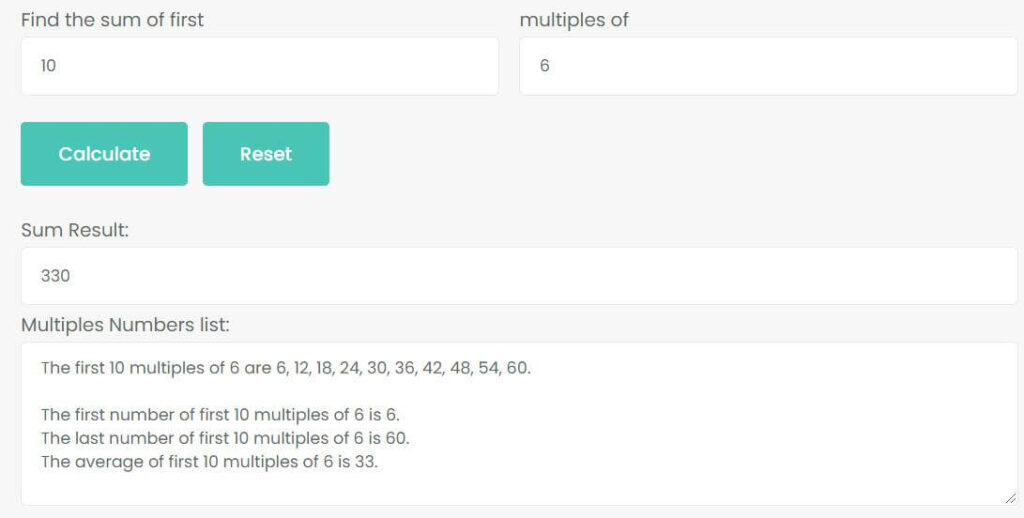Welcome to the sum of first N multiples calculator, as the name suggests, this calculator is used to calculate the sum of first N multiples M. For example, find the sum of first 15 multiples of 8. In here, N stands for 15, M stands for 8.
Sum of first N multiples of M calculator
Obviously, the sum of first N multiples calculator needs to enter two parts of information: one is the exact number of the first N, and the other is the value of the multiple. Like the example above, just input 15 into the first input box and 8 into the second input box, then click calculate button.
 As you can see, in addition to calculating the sum of first 15 multiples of 8, there is also a multiples numbers list, which will list all the numbers in the first 15 multiples of 8. At the same time, their average value will also be calculated. Therefore, the following problems can be easily solved:
As you can see, in addition to calculating the sum of first 15 multiples of 8, there is also a multiples numbers list, which will list all the numbers in the first 15 multiples of 8. At the same time, their average value will also be calculated. Therefore, the following problems can be easily solved:
- What is the sum of the first 15 multiples of 8?
- What are all the numbers in the first 15 multiples of 8?
- What is the first number of first 15 multiples of 8?
- What is the last number of first 15 multiples of 8?
- What is the average of first 15 multiples of 8?
Of course, if you are not calculating the sum of first N multiples, but calculating the sum of multiples in a range, you can use the sum of multiples calculator between A and B.
Solved Examples
Example 1: What is the sum of first 8 multiples of 3?
The first 8 multiples of 3 are
3, 6, 9, 12, 15, 18, 21, 24
So, sum of their is
3 + 6 + 9 + 12 + 15 + 18 + 21 + 24 = 108
Use the sum of first N multiples calculator to calculate the sum of first 8 multiples of 3.
 Thus, the sum of first 8 multiples of 3 is 108. The first number is 3, the last number is 24. The average of first 8 multiples of 3 is 13.5.
Thus, the sum of first 8 multiples of 3 is 108. The first number is 3, the last number is 24. The average of first 8 multiples of 3 is 13.5.
Example 2: Find the sum of first 10 multiples of 6.
The first 10 multiples of 6 are
6, 12, 18, 24, 30, 36, 42, 48, 54, 60
So, sum of their is
6 + 12 + 18 + 24 + 30 + 36 + 42 + 48 + 54 + 60 = 330
Use the sum of first N multiples calculator to calculate the sum of first 10 multiples of 6.
 Thus, the sum of first 10 multiples of 6 is 330. The first number is 6, the last number is 60. The average of first 10 multiples of 6 is 33.
Thus, the sum of first 10 multiples of 6 is 330. The first number is 6, the last number is 60. The average of first 10 multiples of 6 is 33.
Okay, now it is your turn.
Latest calculators
Standard Form to Slope-Intercept Form Calculator
Slope Intercept Form Calculator
Slope Calculator: Calculate Slope, X-Intercept, Y-Intercept
Reciprocal of Complex Number Calculator
Conjugate Complex Number Calculator
Modulus of Complex Number Calculator
Profit Percentage Calculator: Calculate Your Profitability Easily
Attendance and Absence Percentage Calculator
Circular Segment Radius Calculator
Regular Polygon Side Length Calculator
Annulus Calculator for Width, Perimeter, and Area